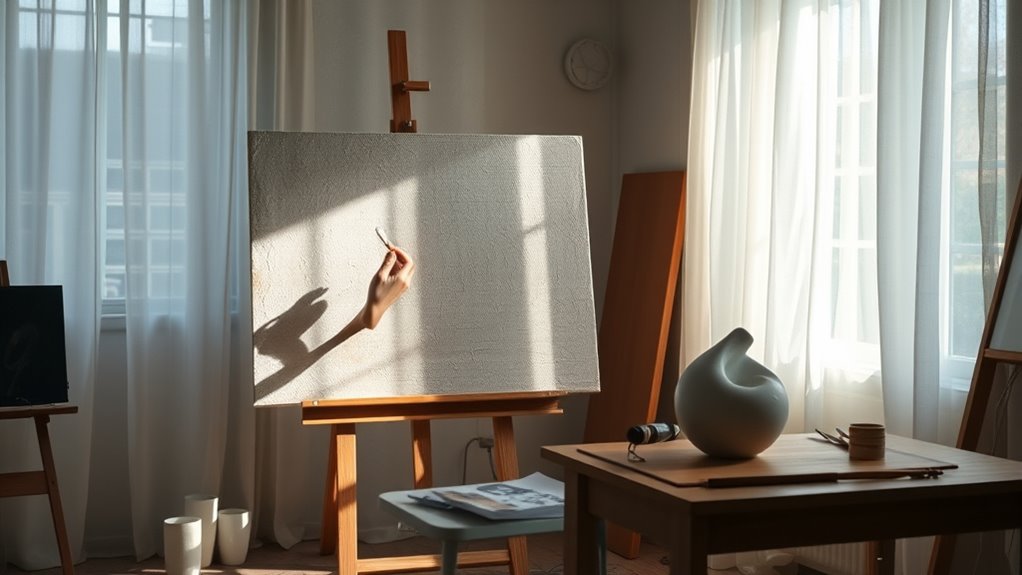The Slow Art Movement invites you to slow down and engage more mindfully with artworks, transforming your viewing into a deliberate and immersive experience. By focusing patiently on details like textures, colors, and craftsmanship, you deepen your understanding and emotional connection. This approach encourages patience and presence, allowing you to appreciate art’s beauty and meaning fully. If you keep exploring, you’ll discover how adopting this mindful method can enrich your entire creative experience.
Key Takeaways
- Emphasizes deliberate, patient engagement with art to foster mindfulness and deeper understanding.
- Encourages slow, focused observation to appreciate craftsmanship and emotional nuances.
- Transforms gallery visits into meditative practices, enhancing presence and reflection.
- Promotes viewing art as a mindful activity that nurtures curiosity and emotional connection.
- Supports a deliberate approach to creativity, emphasizing quality and intention over speed.

Have you ever wondered what it’s like to truly savor a work of art? In a world that moves at lightning speed, appreciating art through a slow, mindful approach can transform the way you connect with creativity. The Slow Art Movement emphasizes taking your time, engaging deeply with each piece, and resisting the impulse to rush through galleries or collections. This movement champions artistic patience and deliberate craftsmanship, encouraging you to slow down and genuinely absorb the nuances of an artwork. Instead of skimming through images or viewing art as a fleeting distraction, you’re invited to spend time contemplating each detail, appreciating the skill and intention behind every brushstroke or sculpture.
By embracing artistic patience, you allow yourself to develop a more meaningful relationship with art. When you approach a piece deliberately, you give yourself permission to linger, to notice the textures, colors, and subtle emotional cues that might otherwise go unnoticed. It’s about resisting the urge to move on quickly and instead, settling into a moment of focused observation. This mindful engagement enhances your understanding and emotional response, fostering a deeper appreciation for the artist’s intent and the craftsmanship involved. The deliberate craftsmanship involved in creating art becomes more apparent when you invest time in observing it. You start to see the precision in a sculptor’s chisel marks or the layered complexity in a painting’s palette. This approach allows you to recognize and value the skill, patience, and dedication that artists pour into their work.
The Slow Art Movement invites you to view art as a form of meditation, a practice of presence rather than a hurried experience. When you take deliberate steps to examine an artwork slowly, you cultivate patience and curiosity. It’s not about the quantity of art you see but the quality of your engagement with each piece. This mindful approach can transform your visits to galleries or your personal collection, turning a casual glance into a profound exploration. As you learn to appreciate the deliberate craftsmanship behind each creation, you’ll find yourself more connected to the artistic process and the stories that unfold within each work. Engaging with art slowly isn’t just about admiration; it’s about creating a space where you can truly experience and cherish the beauty and meaning carefully woven into every detail.
Additionally, cultivating mindful observation can deepen your emotional connection and appreciation for the artistic process, enriching your overall experience with art.
Frequently Asked Questions
How Can Beginners Start Practicing Slow Art?
You can start practicing slow art by setting aside quiet time to focus on mindful techniques like deep breathing and observing details. Begin with simple projects, like sketching or watercolor, and don’t rush. Use beginner resources such as tutorials, books, or online courses to guide you. Emphasize enjoying the process rather than the finished product, allowing yourself to be fully present and mindful during each creative moment.
What Are the Benefits of Slow Art for Mental Health?
Imagine opening a secret garden within your mind—slow art does just that. By practicing mindfulness techniques during your creation, you cultivate emotional regulation and reduce stress. This mindful approach encourages you to stay present, helping you process emotions gently. As you slow down and focus, you’ll notice increased mental clarity, improved mood, and a sense of calm, making slow art a powerful tool for nurturing your mental health.
Which Art Forms Are Best Suited for Slow Creation?
You’ll find that art forms like watercolor painting, calligraphy, and sculpture are best suited for slow creation. These techniques and materials require patience and attention to detail, allowing you to immerse yourself in the process. Cultural influences often enrich these practices, giving you deeper meaning and connection. Taking your time with these arts helps cultivate mindfulness, fostering a calming, reflective experience that benefits your mental well-being.
How Does Slow Art Influence Creativity and Innovation?
Slow art enhances your creativity and innovation by fostering a deeper connection to your artistic process. As you practice creative mindfulness, you become more aware of details and nuances, allowing ideas to develop naturally. This deliberate pace encourages experimentation without pressure, leading to fresh perspectives. By embracing slow art, you open space for original insights, making your creations more thoughtful and innovative, ultimately strengthening your artistic expression.
Are There Specific Environments That Enhance Slow Art Practices?
Imagine stepping into a quiet, sun-dappled forest or a serene, meditative space where gentle breezes whisper. These environments, rich in nature immersion and tranquility, enhance slow art practices by encouraging mindfulness and focused creation. In such settings, you can slow down, connect deeply with your work, and foster authentic creativity. The natural calm helps you embrace patience, making every brushstroke or sculpture more intentional and meaningful.
Conclusion
So, step slow, savor the subtle, and soften your speed. The Slow Art Movement invites you to embrace mindfulness, marvel at moments, and mend your mental maze with meaningful movement. Let your leisure lead to lasting lessons, and your moments morph into memories. Remember, in a world rushing relentlessly, relaxation and reflection reign. Slow, steady, and sincere—your journey to joyful creation begins now. Stop, see, and savor the stunning, silent symphony around you.










